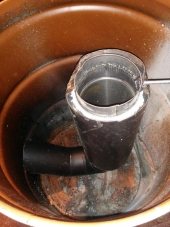posted 8 years ago
Hello there!
So we want to built a rocket mass heater in public space, as a public art installation: It will provide a warm space to hang out during the cold winter in the city. It will be built in November in Germany, and it would be already rather cold outside, perhaps even snowing.
Do you think the cold will affect a lot the effect of the hot air/gas circuit? We thought to insulate extra the bottom of the whole object with vermiculite, as well as the chimney, but we want to be sure that the stove will perform as it normally does, however, we haven’t seen any other stove completely outdoors. (they are usually indoors or in greenhouses)
Apart from that, and since it will be in public space (meaning that it has to be extra safe for regulations), we will not use a barrel for the bell because people might burn, if they don’t know how hot it gets and touch it. And we will not do it with cob, as it is not water resistant. So, we decided to built a complete structure out of bricks, for both the bell and the bench. I can’t find much information about building a bell and a bench out of bricks, so I have a couple of questions.
First of all, the hot air is directed to a shaft which makes a loop and comes back to a chimney which is next to the heat riser. The whole way is about 6 m long. Do you have any clue how hot the air will come out at the end?
I am not sure whether we need to put a metal pipe for the hot air, or simply to built two hollow shafts with the bricks (like in drawing no 2). We thought that maybe with the pipe will be better, because we can insulate it with sand all around and reinforce the thermal mass in that way, but not sure if its necessary.
Another topic is the bench. We have heard that if the top layer is more than 5cm thick, it takes 2 hours to heat up. We wanted to do a layer of bricks and then tiles, and we re wondering if that would be too thick. Any other solutions?
Can someone check the proportions of the wood entrance, the burn tunnel and the heat riser in our drawing and let us know if it seems correct?
Also, do you have any details of how to built the outlet to clean the ashes?
Thank you very much in advance!
Filename: hotstuff161005b-2.pdf
Description: drawing no 1
File size:
111 Kbytes
Filename: hotstuff161005.pdf
Description: drawing no 2
File size:
79 Kbytes









![Filename: hotstuff1.png
Description: [Thumbnail for hotstuff1.png]](/t/59362/a/44085/hotstuff1.png)
![Filename: hotstuff2.png
Description: [Thumbnail for hotstuff2.png]](/t/59362/a/44086/hotstuff2.png)
![Filename: hotstuff3.png
Description: [Thumbnail for hotstuff3.png]](/t/59362/a/44087/hotstuff3.png)
![Filename: hotstuff4.png
Description: [Thumbnail for hotstuff4.png]](/t/59362/a/44088/hotstuff4.png)
![Filename: hotstuff5.png
Description: [Thumbnail for hotstuff5.png]](/t/59362/a/44089/hotstuff5.png)

 1
1





















![Filename: Screen-Shot-2016-11-03-at-22.01.15.png
Description: Section 1 [Thumbnail for Screen-Shot-2016-11-03-at-22.01.15.png]](/t/59362/a/44833/Screen-Shot-2016-11-03-at-22.01.15.png)
![Filename: Screen-Shot-2016-11-03-at-22.01.33.png
Description: Section1.1 [Thumbnail for Screen-Shot-2016-11-03-at-22.01.33.png]](/t/59362/a/44835/Screen-Shot-2016-11-03-at-22.01.33.png)




![Filename: Capture-d-cran-2016-11-03-20.12.26.png
Description: section 2.1 [Thumbnail for Capture-d-cran-2016-11-03-20.12.26.png]](/t/59362/a/44836/Capture-d-cran-2016-11-03-20.12.26.png)



























 2
2

























